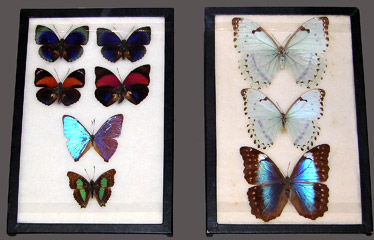Bancroft's Darwin exhibit taps campus's museum, library collections
| 17 September 2009
BERKELEY — An exhibit revealing what inspired and challenged the world’s best known biologist, Charles Darwin, is now open at the University of California, Berkeley’s Bancroft Library in celebration of the 200th anniversary of Darwin's birth.
A selection of rare, illustrated books about travel
and natural history in the 19th century, Darwin’s own writings,
and maps relating to his expedition on the HMS Beagle
help tell the story of "Darwin and the Evolution
of a Theory." Also on display are contemporary images of the virtually
unchanged Galapagos Islands, a wide range of scientific specimens
from UC Berkeley’s
natural history museums and examples of other scientific
theories that supported and opposed Darwin’s during his day.
The Bancroft Gallery exhibit is open through Dec. 23 from 10 a.m. to 4 p.m., Monday through Friday.
 These
butterflies from South America, Asia, and California
(the state insect, the dogface butterfly) are part
of the Essig Museum of Entomology collection. They
were collected in diverse localities closely related
to those that Darwin observed and described.
These
butterflies from South America, Asia, and California
(the state insect, the dogface butterfly) are part
of the Essig Museum of Entomology collection. They
were collected in diverse localities closely related
to those that Darwin observed and described.The Bancroft joins a worldwide commemoration not only of Darwin's bicentenary, but of the 150th anniversary of the publication of his landmark book, "The Origin of Species." The book's presentation of evidence that all species have evolved from common ancestors continues to provoke heated debate.
Darwin was born on Feb. 12, 1809, and published "Origin of the Species" in 1859.
David Farrell, university archivist and The Bancroft’s curator of the history of science and technology, said UC Berkeley's exhibit is unique because it relies on campus materials to demonstrate where Darwin’s ideas came from, the intellectual arguments he faced, the natural world he encountered and which authors – like Mark Twain – and scientists – like geologist Charles Lyell and German naturalist/explorer Alexander von Humboldt – Darwin read and favored.
"We’re making a distinctly UC Berkeley contribution to Darwin Year," said Farrell. "And at the same time, we’re showing a new audience the riches of Berkeley’s libraries and museums."
Keith A. Francis, an associate professor of history at Baylor University in Waco, Texas, and an authority on Darwin collections, said UC Berkeley’s Darwin holdings are superior to those at the British Library, Cambridge University Library or Library of Congress.
"Of the various Darwin collections I’ve worked in, the one at Berkeley is the best for two reasons," Francis said via e-mail. "First, the completeness of the run of editions of Darwin’s works published during his lifetime and of the 'supporting cast,' as I call them — men such as (English biologist) Thomas Huxley and Alfred Russel Wallace (who developed the theory of natural selection). Second, because the Library holds an extensive collection of the American editions of Darwin’s works."
All of the exhibit’s insect, bird, plant and other specimens were collected by UC Berkeley faculty and students in locations such as Chile, New Zealand, Paraguay, Costa Rica and Isla Santa Cruz in the Galapagos Islands. Specimens include an assassin bug from Chile, a common cactus finch and 1.2- to-16 million-years-old fossils, such as the femur of a Mylodon, or giant ground sloth.
In addition, visitors will see a detailed model of the HMS Beagle that was built by noted model maker Lloyd McCaffery out of materials including balsa wood, holly, apple and boxwood and loaned to the exhibit by a private collector in the UC Berkeley Class of 1965. One exhibit case contains a facsimile of Darwin’s diary and a rare copy of a published compilation of Darwin’s letters from the Beagle expedition. The letters were the scientist’s first public appearance in print.
To create the exhibit, Farrell, Bancroft rare books curator Anthony Bliss and Kevin Padian, a UC Berkeley professor of paleontology and Museum of Paleontology curator, combed the Bancroft and other campus libraries, also exploring the Museum of Paleontology, Museum of Vertebrate Zoology, the University and Jepson Herbaria, the Essig Museum of Entomology and the Phoebe A. Hearst Museum of Anthropology.
The Bancroft and the Bioscience and Natural Resources Library’s Charles Kofoid Collection were important sources for the exhibit’s display of Darwin’s published books, and the exhibit includes a complete assembly of everything Darwin published in England and the United States. Kofoid, a UC Berkeley zoology professor for more than 25 years, amassed a library of materials on science and medicine that includes 530 volumes on or by Darwin. He donated the collection to UC Berkeley in 1947.
From the Hearst Museum came gaucho gear that resembles the clothing and devices that Darwin would have seen on his South American shore excursions and collected from the Pampas and Patagonia in Argentina in the 1920s.
Throughout the fall semester, Darwin-related programs and courses are scheduled on campus. They include:
- A panel discussion on "Darwin’s Enduring Legacy" to be held at 7 p.m., Wednesday, Nov. 4, in the Maude Fife Room in Wheeler Hall and hosted by The Bancroft Library and Townsend Center for the Humanities.
- In UC Berkeley’s History of Art Department, an undergraduate seminar on artists’ visualization between 1859 and 1937 of the concept of evolution by natural selection, and the concept of beauty as an element of natural selection.
- Anthropology professor Meg Conkey's course “The Cave Man Mystique,” in which she and her students are interpreting and attempting to understand human ancestry as seen in Darwin’s legacies.
- Anthropology professor Terrence Deacon's class exploring the evolution of human behavior and how such fields as behavioral genetics, evolutionary psychology and behavioral ecology hold up to current research findings on brain function, gene expression and behavioral development.
- A course by history professor John Lesch looking at Darwin and evolution as part of an examination of life sciences from 1750 to the late 20th century

